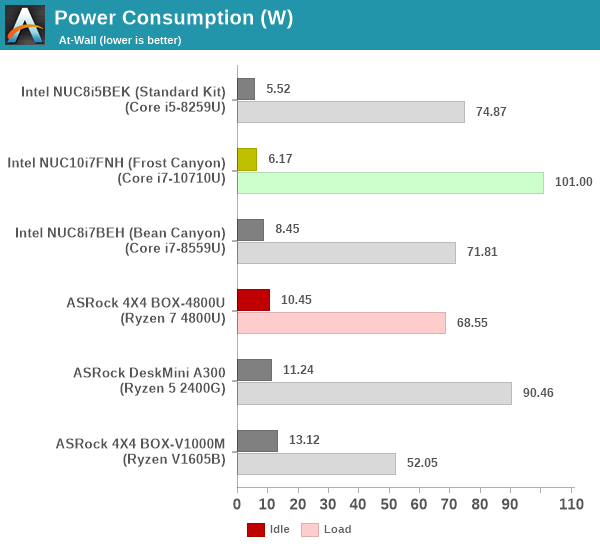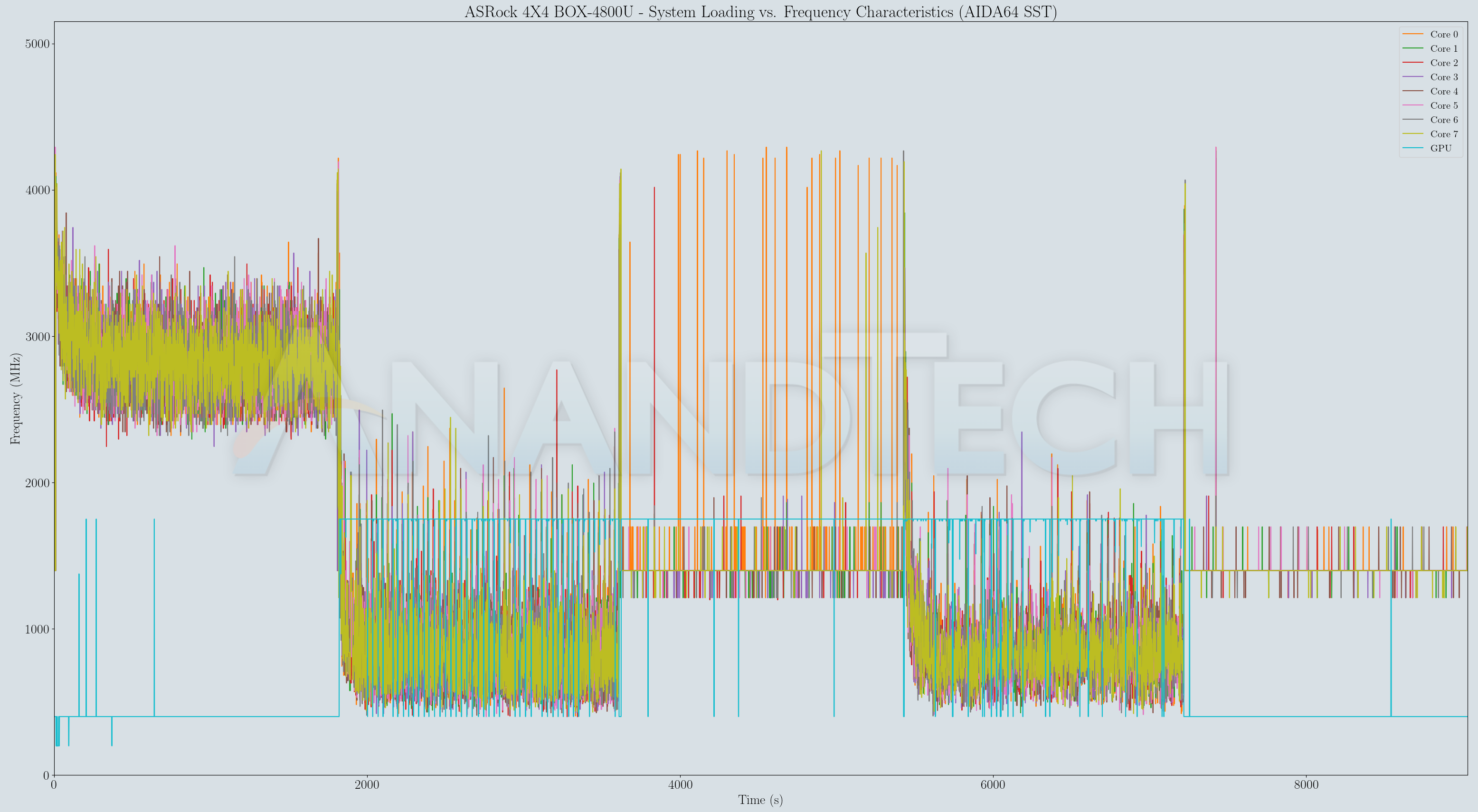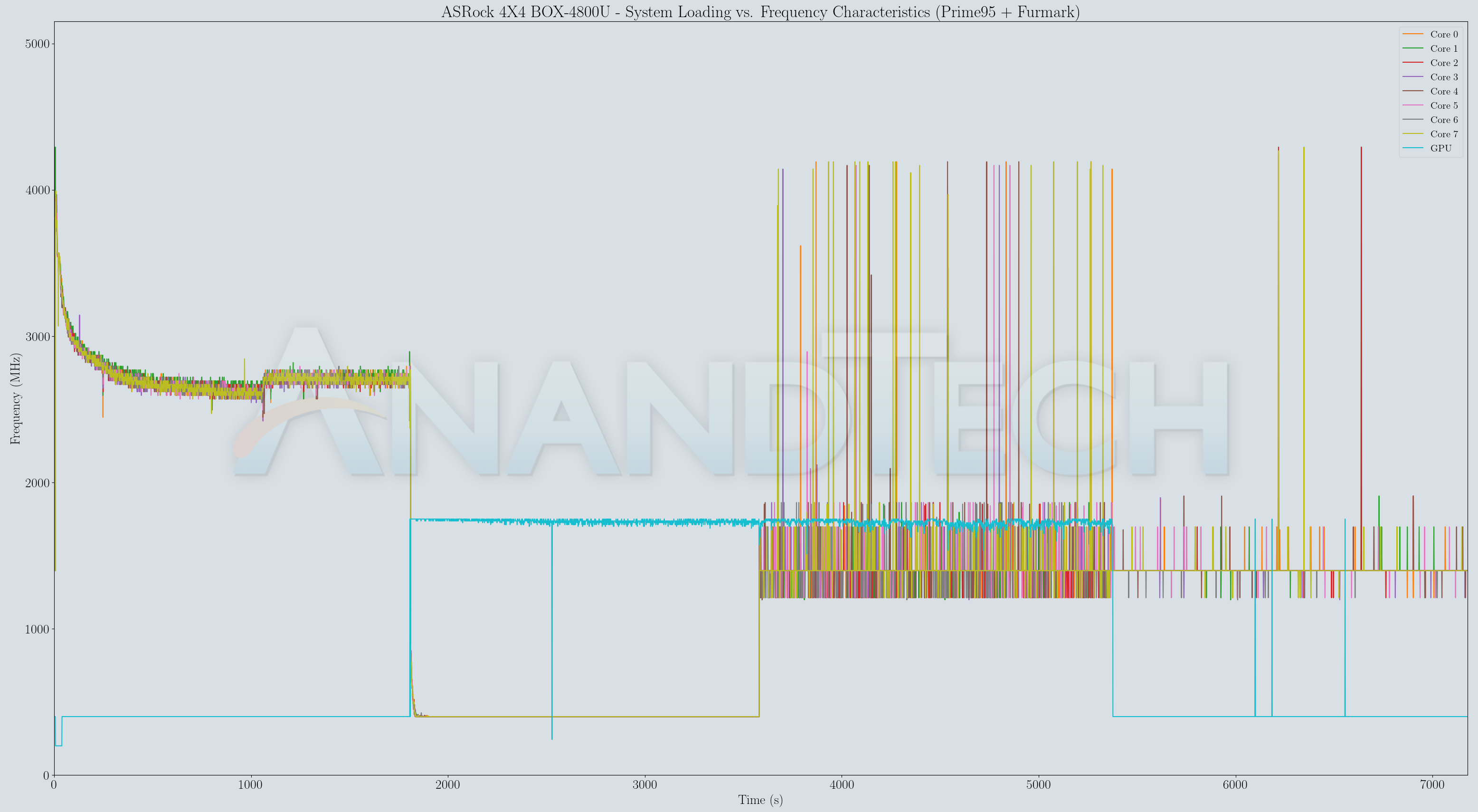ASRock Brings Zen 2 NUC : 4X4 BOX-4800U Renoir Mini-PC Reviewed
by Ganesh T S on November 25, 2020 11:00 AM ESTPower Consumption and Thermal Performance
The power consumption at the wall was measured with a 4K display being driven through the HDMI port. In the graphs below, we compare the idle and load power of the ASRock 4X4 BOX-4800U with other low power PCs evaluated before. For load power consumption, we ran the AIDA64 System Stability Test with various stress components, and noted the maximum sustained power consumption at the wall.

The idle power of 10.45W is a tad too high compared to the Intel NUCs. The peak power consumption is also low, compared to other systems.
Our thermal stress routine starts with the system at idle, followed by four stages of different system loading profiles using the AIDA64 System Stability Test (each of 30 minutes duration). In the first stage, we stress the CPU, caches and RAM. In the second stage, we add the GPU to the above list. In the third stage, we stress the GPU standalone. In the final stage, we stress all the system components (including the disks). Beyond this, we leave the unit idle in order to determine how quickly the various temperatures in the system can come back to normal idling range. The various clocks, temperatures and power consumption numbers for the system during the above routine are presented in the graphs below.
| ASRock 4X4 BOX-4800U System Loading with the AIDA64 System Stability Test | |||

The frequencies stay above the base value (1.8 GHz) advertised. Being actively cooled, the temperature of the package doesn't exceed 95C. The key is the package power - for CPU alone, the steady state is around 15W. With the GPU in the mix, it goes up to around 20W (though instantaneous values go as high as 30W for very short bursts).
| ASRock 4X4 BOX-4800U System Loading with Prime95 and Furmark | |||

The artificial power virus test of both Prime95 and Furmark results in the package temperature going as high as 100C. According to the official specifications, the maximum permitted temperature of the Ryzen 7 4800U is 105C. The thermal solution is able to keep it below that number, allowing the processor to deliver its advertised performance in a sustained manner.










53 Comments
View All Comments
hlovatt - Wednesday, November 25, 2020 - link
It would be great to see a comparison with new Mac Mini M1jgraham11 - Wednesday, November 25, 2020 - link
Ganesh why would you use a Bapco Benchmark - Mobilemark. Its results are complete crap. You must not know the history of Bapco and how its basically an arm of Intel, made for Intel chips.Notice how the AMD 4800U loses in every benchmark with Mobilemark and consumes more power doing it but when you look at the other results, synthetic or otherwise its mostly in AMDs favour... Intel benchmarking tools at work. This is a known thing among everyone who follows this stuff. If you want to maintain your credibility stick to independent benchmarks not ones made by the vendor for the vendors own chips.
brucethemoose - Wednesday, November 25, 2020 - link
I feel like the 35W 4800HS, with a bit more cooling, would be a better sweet spot for this form factor.Speaking of which, my 4900HS doesn't idle that hot. But I did notice that it behaves quite differently when running on battery (where it drops down to 400Mhz) and on AC (where it wont go below 1GHz, even though the cores are largely asleep). Its possible that this 4800U is stuck in the Windows "plugged in" profile.
TheinsanegamerN - Tuesday, December 1, 2020 - link
Given the box pulls 65 watt, there is no way it’s sticking to its TDP. A 4800hs would likely perform the same to slightly worse, given its smaller GPUsix_tymes - Wednesday, November 25, 2020 - link
I hope to see these with DDR5. anyone knows when DDR5 platforms are suppose to roll out?James5mith - Wednesday, November 25, 2020 - link
2021-2022 timeframe.5080 - Wednesday, November 25, 2020 - link
IMO the real breakthrough in this formfactor will come for AMD once they move to ZEN4/Navi based APU's on 5nm with DDR5 and USB4.0 in 2022.PixyMisa - Thursday, November 26, 2020 - link
Yes. They could add more graphics cores, but without also adding memory bandwidth that won't achieve much. DDR5 will break that bottleneck.Spunjji - Friday, November 27, 2020 - link
I'm thinking the biggest boost would come from combining DDR5 with a larger local cache a-la "Infinity cache" - 5nm should give them enough spare die area to achieve that, and it'll presumably help keep the power draw lower than stuffing the entire area with logic would.meacupla - Wednesday, November 25, 2020 - link
I just want to point out that on the spec chart, you only list "USB 3.2 Type-C", but there is clearly more to it than that, as that spec can be 10GB, 20GB, alt-mode DP, alt-mode HDMI.I know it's clearly marked as 10GB alt-DP in the pictures.
aside from that
When are manufacturers going to switch over to USB-C PD for these smaller devices? I know that USB-C PD can do 100W and this thing only eats 70W at full load from the wall.